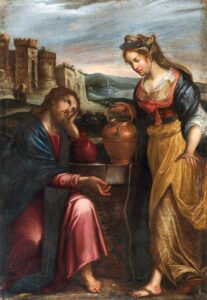Thoughts on the Cabrini Movie
by Fr. William Rock, FSSP

On the Saturday evening of its opening weekend, I took the parish’s Young Adult group to see the Cabrini movie. I brought along with me a second-class relic of Mother Cabrini which once belonged to my grandparents. When I asked my mother about the relic, she said that she remembers a daytrip taken one summer when she was little. She and her family – great-grandmother, grandmother, aunts, uncles, cousins, etc. – traveled from their home in New Jersey to the Cabrini Shrine in New York. Perhaps, my mother suspects, the relic came from this visit. I can only surmise what having this relic must have meant to my Italian-American ancestors. For my mother’s mother’s family is from the town of Cerami in Sicily, while her father’s side is from different communities in the south-eastern part of Italian peninsula. Not too long before the events depicted in Cabrini, southern Italy and Sicily were an independent kingdom which was unjustly invaded and then incorporated into the newly-formed Kingdom of Italy. Prior to this “unification,” the majority of emigration was from the north. But afterwards, no doubt due to the conditions which followed “unification,” there was mass emigration from the south and Sicily. Although she was from the north, it was primarily these immigrants from the south and Sicily whom Mother Cabrini served in New York. So then, not only did I go to see a movie about the first canonized American citizen, but also to see a portrayal of how my mother’s people, how my people – though not necessarily members of our family – were treated when they first arrived in these United States. A part of American history which is perhaps not well-known.
After the movie was over, I was asked what I thought about the movie by the Young Adults. I told them, at the time, it was a lot to process, but in a good way. In the hallway outside of the theater, I shared the relic with the Young Adults and then gave them a blessing before we departed.

As I continued to process my experience of the movie, I settled on the following. First, and most importantly, I do not believe I have ever felt the same after watching any other movie. There was calm, a peace, a quiet joy or happiness. Trying to place the movie among others which might be like it, I settled on Gettysburg or Gods and Generals. This, of course, should be taken with a grain of salt as I am not a film critic by any stretch (and it has been a while since I have seen these movies). But, as of the writing of this article, Cabrini stands with a 91% critics’ score and a 98% audience score (based on over 1,000 audience reviews) on the Rotten Tomatoes website. In my opinion, for what it is worth, to call this a “good movie” would not do it justice.
It does seem, however, that there is a somewhat negative reception of this movie among Catholics due to disappointment over the perceived lack of prayer, Catholic spirituality, and God. Responding to this criticism, I would start by saying that I think it is important to keep in mind what this film actually is. It is distributed by Angel Studios which is, if we were to assign a religious tag to it, Mormon. The movie was intended for a general viewership not a specifically Catholic one, unlike movies offered by EWTN or other such outlets of Catholic media. It is a movie about Catholics, but not a “Catholic movie,” and it was never intended to be. It is a movie about a Catholic saint, but not a “saint movie,” and it was never intended to be. It was never intended to be a Song of Bernadette, a Reluctant Saint, or a Passion. We should not hold this movie to a standard it was not trying to meet.

Additionally, I think it is providential that the movie came out on the Friday of the Third Week of Lent. The Gospel of the day is the account of Our Lord and the Woman at the Well (John 4:5-42). Our Lord did not begin the conversation by saying “I am the Christ and you are a sinner.” Rather, He began by saying something more innocuous – “Give Me to drink” of the water of the well. Then, from this beginning, He went deeper. I think this movie is something similar – it is only the beginning of the conversation, a conversation which can, and hopefully will, go deeper.1 But, if it started too deep, if it was too heavy-handed, so to speak, it would most likely put folks off.
It should also be noted that the movie is not completely void of any references to God or spirituality. A Priest is shown carrying around what I assume is his breviary. There is a funeral procession. Religious images are seen the backgrounds. Mother Cabrini and her daughters are shown praying grace, in Latin, before eating and, when she is in Rome, she is shown praying in a chapel. She also makes references to/quotes Scripture (such as Philippians 4:13), even if the references are subtle. I think that this is the case with the movie overall – the presentation of Catholicism is subtle, being expressed as a major part of the warp and weft of the characters’ lives without calling undue attention to itself. The presentation, then, is not heavy-handed, which goes back to the point considered in the preceding paragraph.

When I recommended seeing Cabrini, either in person or on the Ask A Priest Live program, before I had seen the movie, I did state that I had heard that her spiritual life was downplayed, but that the movie should still be seen. Now, after having seen the movie for myself, I even more whole-heartly recommend seeing it, but with proper expectations – that is, not holding this movie to a standard it was never trying to meet, keeping in mind the actual target audience, and not letting the perfect be the enemy of the good – so that it can be appreciated for what it is.
Mother Cabrini, Pray for us!
Fr. William Rock, FSSP was ordained in the fall of 2019 and is currently assigned to Regina Caeli Parish in Houston, TX.
In support of the causes of Blessed Maria Cristina, Queen, and Servant of God Francesco II, King
- Further and deeper discussion can be aided by using additional materials such as those made available by Sophia Press (here, here, and here).
March 13, 2024









